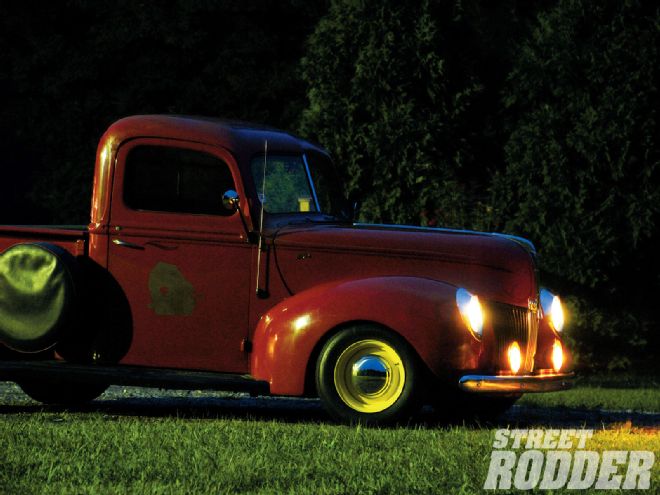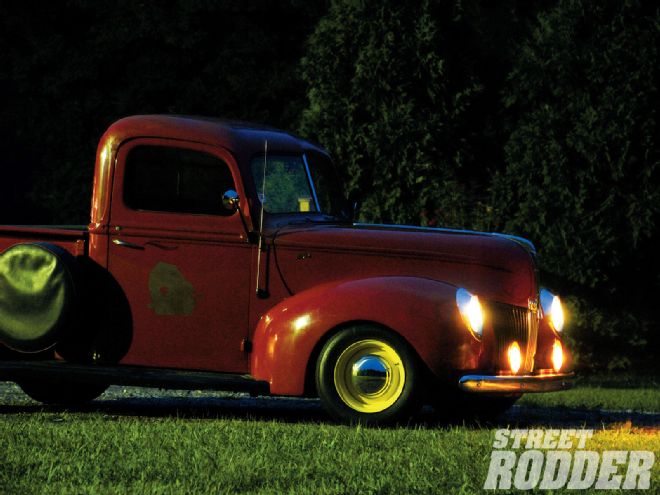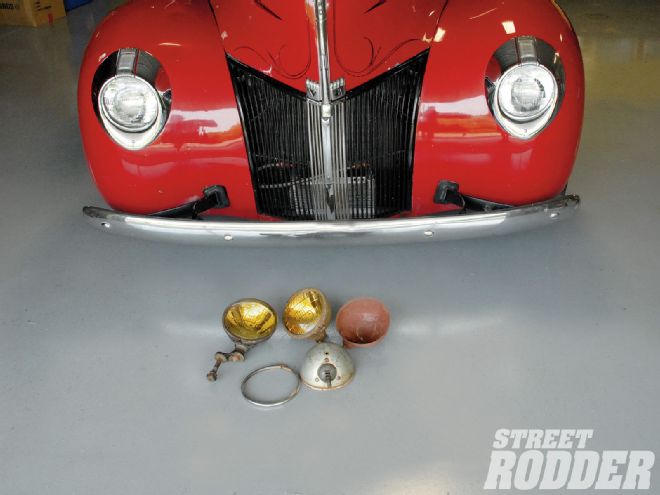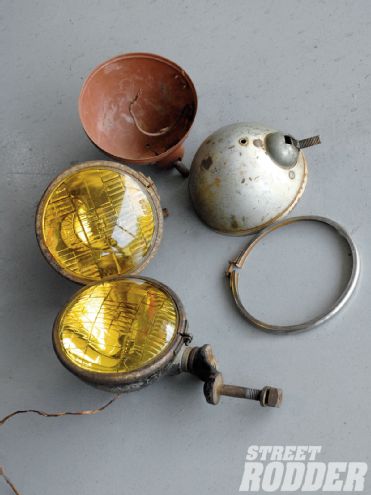
Not too many folks at a rod run or local cruise night are sitting around bragging about how great their night vision is these days. It's just a function of age and if you're over 40 or 50 years old, chances are you've noticed a marked reduction in night vision. Plus, with the vast improvements in lighting on late-model cars, we've come to expect better lighting. Since this particular writer is well into the night blindness years, it seemed reasonable to look for some auxiliary lighting for the '40 Ford pickup located in the garage.

Like anything you choose to put on a street rod, there must be a reasonable mix between form and function. Sure it's important to see well at night, but let's face it, not at the expense of losing all-important style points. While it is important that one arrive at the rod run, it is even more important that you look cool upon arrival. And so our search for appropriate night lighting began in earnest in the swap meet at the NSRA Nats East in York, Pennsylvania. It was there that we stumbled across a very nice King Bee foglight, complete with a 6-volt sealed beam and mounting bracket. After some negotiation we left with light-some $70 lighter n the pocket.
We considered running just one light, it's kind of trendy to do the single light, asymmetrical trick these days, but we had two problems with this approach. Namely, since both eyes lack good night vision, which side to mount the foglight on became a bit of a tough decision. The second problem is the whole trendy one-light thing, and so we decided to look for a second light. This arduous task involved literally walking about 30 feet to chat with longtime vintage parts vendor and friend Nick Nerriccio. Same swap meet, same aisle, Nerriccio has tons of old speed equipment and a long love of '33-42 Willys automobiles too. If he doesn't have a part he often knows who does.
Nerriccio sees the light and says, "You need King Bee foglights? I must have a half dozen of them at the shop." This made me wonder why I just didn't ask him in the first place, but anyway after dropping him an email (mrnick@cox.net) and agreeing on a price, a second King Bee foglight arrived via the brown truck.
It should be noted that reproduction King Bee lights are available for around $120 each and they come with a chrome bezel and primered bucket, halogen bulbs, and a great-looking lens that produces superior lighting compared to a sealed beam. Replacement parts are also available, the trim ring, halogen bulb, reflector, and lens can all be purchased separately. Your favorite rod shop should be able to access these lights for you, but for some of us the lure of "the real thing" is too strong to resist.
The first order of business was actually restoring the driving lights. The King Bee No. 98-99 light is a fairly common light, so search around for lights worth saving, no need to be doing extensive damage control, just to find a good light. Our lights had typical 50-year-old problems with minor surface rust, a dent or two and of course aged wiring. We stripped the buckets with a soft abrasive disc on an air grinder and then carefully metalworked two or three dents with a hammer and dolly.
 Installing King Bee driving lights on our '40 Ford will provide added style and all-important improvement in night vision. We chose amber bulbs, but clear lights are also available.
Installing King Bee driving lights on our '40 Ford will provide added style and all-important improvement in night vision. We chose amber bulbs, but clear lights are also available.
Next a couple of coats of primer were sprayed, sanding between coats with 320-grit paper. The final primer was 400 sanded and then we top-coated with Krylon semi-flat black finish to match the grille in the truck. The driving light rims were treated in a similar fashion, but the topcoat was a basecoat/clear that is intended for refinishing alloy wheels. We used a product from Wurth, but similar paint is available from Dupli-Color at your local parts store. We really like the look of this product and since it comes in rattle cans there is no need to be mixing paint and cleaning spray guns. All finishes on the lights, including the primer were applied from spray cans.
With the cosmetics out of the way we made a trip to the local parts store and purchased a pair of wiring plugs for a trailer. These two-wire plugs come with a weather-proof plug, this makes both installing and removing the lights easy, should the need arise. While at our local parts store we ordered two 12-volt amber sealed beams to fit the lights, at a cost of almost $20 each. Since these foglights have screws and terminals, no plugs were required inside the light. The final piece of the puzzle came in the form of a very cool, lighted switch by Hella that has a vintage look. These lights were used in '80s vintage foreign cars, such as Porsches, and since we wanted to keep the vintage look going inside, it worked out fine. An added bonus is the switch comes with several color lenses, when the lights are on the knob illuminates in amber, green, or red; we went with the amber for what should be obvious reasons.
Now it was time to make some brackets and actually install the lights on the front of our '40 Ford. The first, and possibly the most important part of the job is finding the right location for the lights. We located them down low, with the bracket flush with the top of the bumper, using one bumper bolt to fasten the brackets to the bumper. The brackets allowed the sealed beam to be perfectly aligned with the front of the bumper. Position the lights carefully. Moving the lights too far forward gives you the dreaded frog-eye look, too far back and they crowd the body. Once we were certain of the proper location, we formed some brackets from stainless steel sheet, using basic hand tools and a Woodward Tool shear and sheetmetal brake we have in our shop.
The stainless steel we used was only 16-gauge, and we were hoping by building a gusseted bracket the lights would be stable. Unfortunately that was not the case so a piece of 1/8-inch stainless steel flat stock was bent on a 90-degree angle and added under the initial bracket. This stiffened the bracket enough so the lights no longer vibrate when driving. In the future we will simply make the brackets using 1/8-inch stock. The single bolt was tightened and the lights were finally mounted.
 We ended up with several vintage King Bee lights, and did the pick and choose thing to get the best parts. Reproduction King Bee lights are available in chrome, painted, or polished stainless with halogen bulbs.
We ended up with several vintage King Bee lights, and did the pick and choose thing to get the best parts. Reproduction King Bee lights are available in chrome, painted, or polished stainless with halogen bulbs.
The metal fabrication, wiring, and lighting were all very straight forward but it still took us the better part of a weekend to complete the project.
After properly aiming the driving lights they do a fine job of filling in the dark area just in front of the truck and behind the headlight beams. In the end, we earned several style points and the additional lighting at night makes driving our '40 Ford a pleasure, since now we can see where we're going.